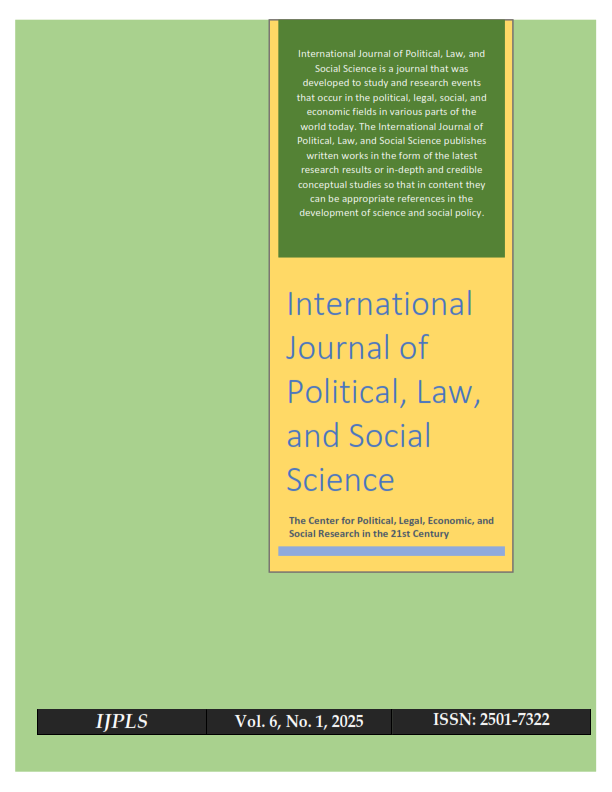LIVING BY THE RIVER: EXPLORING SOCIO-ECONOMIC REALITIES OF RIVERSIDE COMMUNITIES IN BANJARMASIN
Keywords:
Banjarmasin, Education Access, Riverside Communities, Socio-Economic Conditions, Sustainable DevelopmentAbstract
Riverside communities in Banjarmasin, Indonesia, face intertwined economic and social challenges shaped by their dependence on river-based livelihoods. This study examines household income, employment patterns, education, health, and community cohesion among 250 riverside households selected through stratified random sampling. Data analysis employed descriptive statistics, chi-square tests, and regression analysis. Results show that 62% of households depend on informal river-related activities such as floating markets, fisheries, and boat transportation, with average monthly incomes below the regional minimum wage. Approximately 48% of respondents experience irregular employment, 36% of children have limited access to secondary education, and 42% of households report recurrent health issues linked to sanitation and flooding. Statistical analysis reveals a significant association between household income and access to education (χ² = 18.47, p < 0.01), while regression results indicate that education level significantly predicts household income (β = 0.41, p < 0.001). These findings underscore the urgency of integrated policies that promote education, strengthen infrastructure, and expand river-based economic opportunities. The study concludes that inclusive development strategies are essential to enhance resilience and sustainability in Banjarmasin’s riverside communities.
References
Adger, W. N. (2000). Social and ecological resilience: are they related? Progress in Human Geography, 24(3), 347–364. https://doi.org/10.1191/030913200701540465
Agrawal, A., & Gibson, C. C. (1999). Enchantment and disenchantment: The role of community in natural resource conservation. World Development, 27(4), 629–649. https://doi.org/10.1016/S0305-750X(98)00161-2
Ahsan, D. A. (2011). Farmers’ motivations, risk perceptions and risk management strategies in a developing economy: Bangladesh experience. Journal of Risk Research, 14(3), 325–349. https://doi.org/10.1080/13669877.2010.541558
Alam, G. M., Alam, K., & Mushtaq, S. (2017). Climate change perceptions and local adaptation strategies of hazard-prone rural households in Bangladesh. Climate Risk Management, 17, 52–63. https://doi.org/10.1016/j.crm.2017.06.006
Allison, E. H., & Ellis, F. (2001). The livelihoods approach and management of small-scale fisheries. Marine Policy, 25(5), 377–388. https://doi.org/10.1016/S0308-597X(01)00023-9
Bebbington, A. (1999). Capitals and capabilities: A framework for analyzing peasant viability, rural livelihoods and poverty. World Development, 27(12), 2021–2044. https://doi.org/10.1016/S0305-750X(99)00104-7
Blaikie, P., Cannon, T., Davis, I., & Wisner, B. (2014). At Risk: Natural hazards, people’s vulnerability and disasters. Routledge. https://doi.org/10.4324/9781315628525
Bryceson, D. F. (2002). The scramble in Africa: Reorienting rural livelihoods. World Development, 30(5), 725–739. https://doi.org/10.1016/S0305-750X(02)00006-2
Béné, C., Hersoug, B., & Allison, E. H. (2010). Not by rent alone: Analyzing the pro-poor functions of small-scale fisheries in developing countries. Development Policy Review, 28(3), 325–358. https://doi.org/10.1111/j.1467-7679.2010.00486.x
Chambers, R., & Conway, G. R. (1992). Sustainable rural livelihoods: Practical concepts for the 21st century. IDS Discussion Paper 296.
Cleaver, F. (2005). The inequality of social capital and the reproduction of chronic poverty. World Development, 33(6), 893–906. https://doi.org/10.1016/j.worlddev.2004.09.015
Cohen, A., & McCarthy, J. (2015). Reviewing rescaling: Strengthening the case for environmental considerations. Progress in Human Geography, 39(1), 3–25. https://doi.org/10.1177/0309132514521483
Coleman, J. S. (1988). Social capital in the creation of human capital. American Journal of Sociology, 94, S95–S120. https://doi.org/10.1086/228943
Dasgupta, P. (2001). Human well-being and the natural environment. Oxford University Press.
Ellis, F. (2000). Rural livelihoods and diversity in developing countries. Oxford University Press.
FAO. (2012). The State of World Fisheries and Aquaculture. Food and Agriculture Organization of the United Nations.
Fabricius, C., Koch, E., Turner, S., & Magome, H. (2004). Rights, resources and rural development: Community-based natural resource management in Southern Africa. Routledge.
Ferguson, J. (1990). The anti-politics machine: “Development,” depoliticization, and bureaucratic power in Lesotho. Cambridge University Press.
Flick, U. (2014). An introduction to qualitative research. Sage.
Giddens, A. (1984). The constitution of society: Outline of the theory of structuration. University of California Press.
Granovetter, M. (1985). Economic action and social structure: The problem of embeddedness. American Journal of Sociology, 91(3), 481–510. https://doi.org/10.1086/228311
Harriss, J., Hunter, J., & Lewis, C. (1995). The new institutional economics and third world development. Routledge.
Hentschel, J., Lanjouw, J. O., Lanjouw, P., & Poggi, J. (2000). Combining census and survey data to study spatial dimensions of poverty: A case study of Ecuador. World Bank Economic Review, 14(1), 147–165. https://doi.org/10.1093/wber/14.1.147
Jentoft, S., & Chuenpagdee, R. (2009). Fisheries and coastal governance as a wicked problem. Marine Policy, 33(4), 553–560. https://doi.org/10.1016/j.marpol.2008.12.002
Long, N. (2001). Development sociology: Actor perspectives. Routledge.
Marsden, T., Murdoch, J., Lowe, P., Munton, R., & Flynn, A. (1993). Constructing the countryside. UCL Press.
Moser, C. O. N. (1998). The asset vulnerability framework: Reassessing urban poverty reduction strategies. World Development, 26(1), 1–19. https://doi.org/10.1016/S0305-750X(97)10015-8
Narayan, D. (1999). Bonds and bridges: Social capital and poverty. World Bank Policy Research Working Paper No. 2167.
North, D. C. (1990). Institutions, institutional change and economic performance. Cambridge University Press.
Ostrom, E. (1990). Governing the commons: The evolution of institutions for collective action. Cambridge University Press.
Portes, A. (1998). Social capital: Its origins and applications in modern sociology. Annual Review of Sociology, 24(1), 1–24. https://doi.org/10.1146/annurev.soc.24.1.1
Putnam, R. D. (1993). Making democracy work: Civic traditions in modern Italy. Princeton University Press.
Putnam, R. D. (2000). Bowling alone: The collapse and revival of American community. Simon & Schuster.
Scoones, I. (1998). Sustainable rural livelihoods: A framework for analysis. IDS Working Paper 72.
Sen, A. (1999). Development as freedom. Oxford University Press.
Silver, H. (1994). Social exclusion and social solidarity: Three paradigms. International Labour Review, 133(5–6), 531–578.
Small, M. L. (2009). Unanticipated gains: Origins of network inequality in everyday life. Oxford University Press.
Tacoli, C. (1999). Understanding the opportunities and constraints for low-income groups in the peri-urban interface: The contribution of livelihood frameworks. Environment and Urbanization, 11(1), 13–26. https://doi.org/10.1177/095624789901100104
UNDP. (2020). Human Development Report 2020. United Nations Development Programme.
World Bank. (2018). Poverty and Shared Prosperity 2018: Piecing together the poverty puzzle. World Bank.














